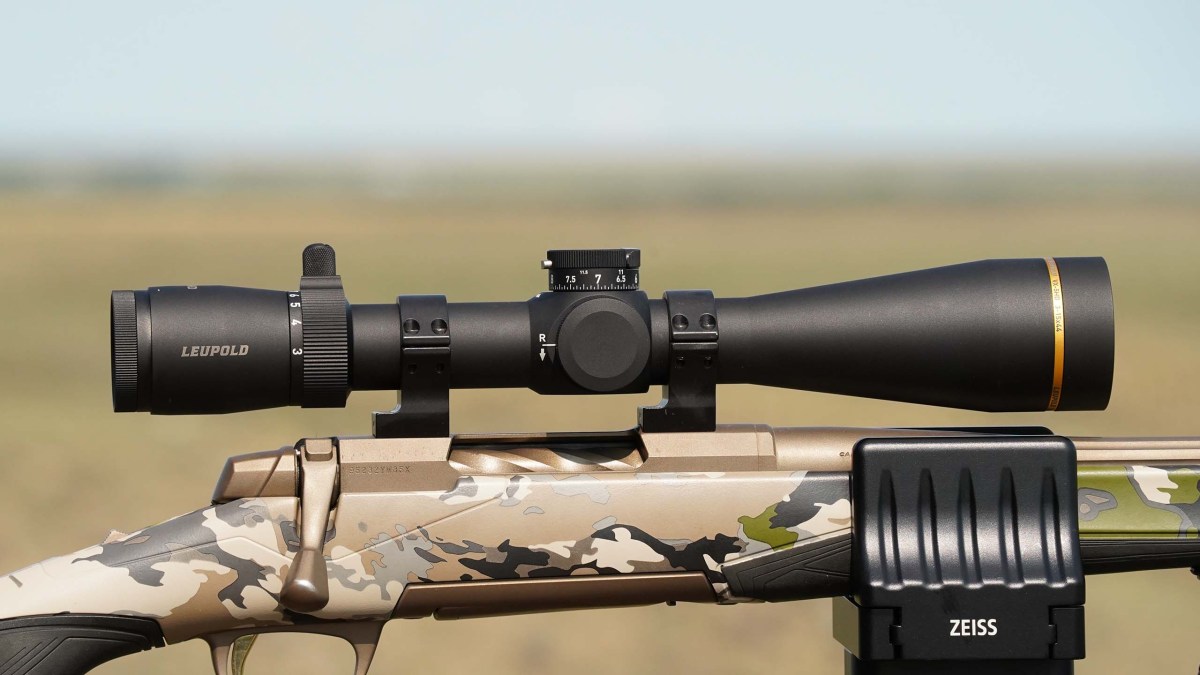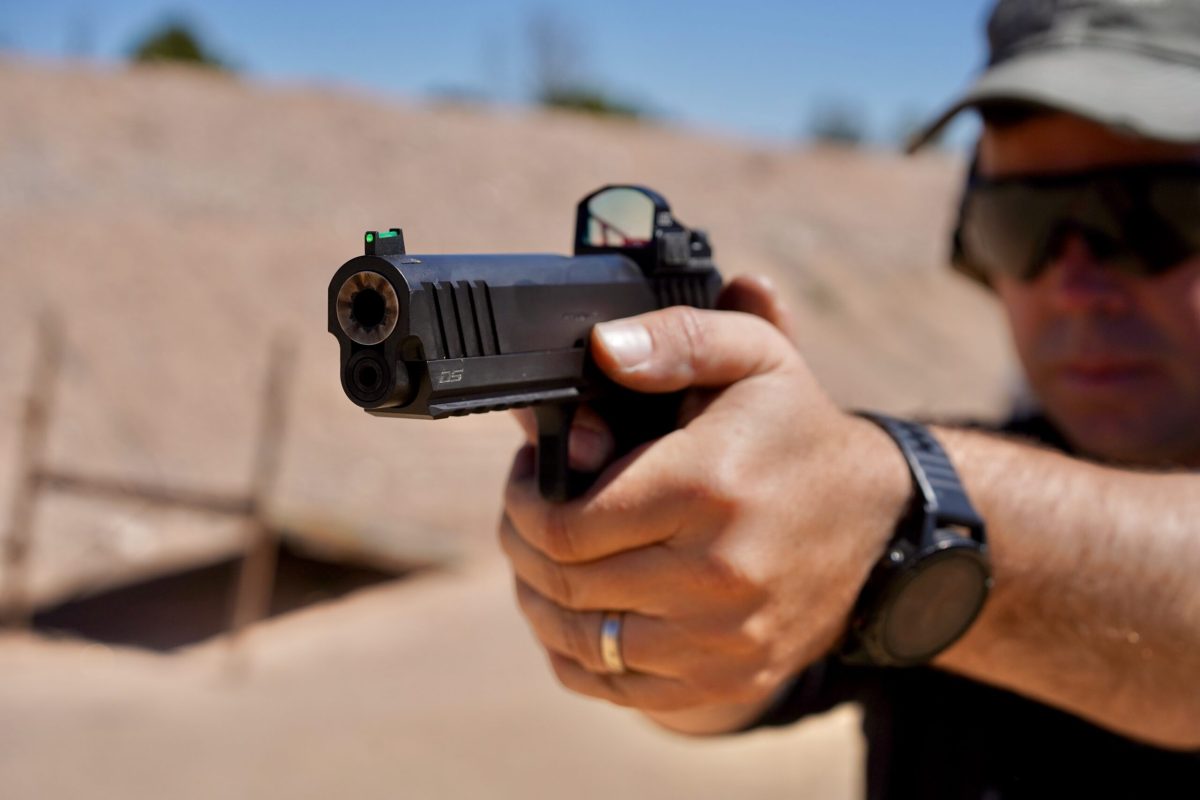The Hunt for the Jameson Buck, a 250-Inch Legend That Lived in an Old Strip Mine

This story, “Ghost Buck,” appeared in the November 1991 issue of Outdoor Life. The Bruce Jameson buck ultimately scored 248 1/8 inches after deductions, according to Boone and Crockett. Although it was one of the top-scoring archery bucks of all time when it was killed, it’s listed as the 15th largest nontypical ever taken in Kansas. Though the story mentions Pope and Young, Jameson’s name isn’t listed among its records. The rack is now owned by Bass Pro Shops.
The big whitetail moved steadily, head lowered, nosing a course through a lunarlike landscape of earth mounds, dark puddles and hair-thick brush. Strip mining had turned the area raw and made hunting supremely difficult. Yet this giant of a buck moved on. Something compelled him, an urge perhaps. It was mid-November, the peak of the rut.
Then abruptly the buck froze, as if gripped by an old instinct for caution. From atop a rise, he surveyed the area.
To bowhunter Bruce Jameson, who knelt against the base of a cottonwood 50 yards away, it was now clear that all of the speculation about the buck had been true. Somehow the hundreds of hunters before him who had failed to get a close look at this ghost buck had emerged with an accurate picture — perhaps because it was nearly impossible to exaggerate in describing the animal. Everything about the buck was massive. His long, heavy body seemed to melt into a neck that was a barrel of solid muscle from supporting his towering, forearm-thick antlers. The bowhunter clutched his compound Pearson Spoiler and saw his knuckles turn a splotchy white.
This buck, so well-known but seldom seen, had drawn Jameson into the woods 20 of the past 21 mornings. He had been taunted by a combination of too much distance and brush. Day after day, there had been no clear shot. Still, the bowhunter felt a kind of jubilation as he watched the world-class whitetail lower his head and fade into the brush. After all, he had just accomplished something no other hunter had — he had seen the ghost buck while hunting.
At the time, the walls of Jameson’s Pittsburg, Kansas, bowhunting and taxidermy shop were lined with big-game mounts. Most were whitetail bucks of enviable size. Still, to a mount, they were overshadowed by one buck in particular, which, once noticed, instantly took your eyes away from the rest. Hunters had come from all parts of southeastern Kansas to marvel at this huge non-typical buck. His main beams were nearly as thick as a softball where they rose from the mount, and they thickened as they climbed into a crown of spike like points. When displayed at a trophy deer show, people had crowded around, labeling it the most impressive non-typical to come from a state that’s been dominating the record books for a quarter-century.
Equally provocative was the fact that the deer was still in the wild. The display cape was that of another buck. The gargantuan antlers had been found after the ghost buck had shed them the previous winter. It wasn’t the first time, either.
Deer hunters around town got their first hint of an exceptional horned buck when John Jameson, Bruce’s father, happened upon a shed antler during a 1987 bowhunt. Though bleached from the sun and pocked by rodents, there was no mistaking that it came from a trophy buck. The single antler was unusually massive and sported eight points.
Local hunters were surprised that no one had ever seen the buck that carried it. Many speculated that the beast had already died a natural death. The following spring though, Jameson’s nephew, Doug Kratz, discovered that the ghost was still in their presence when he happened across a massive, freshly shed antler. A few weeks later the other side, an eye opening set, also turned up. Together the two antlers carried a total of 22 points.
The presence of the big buck in the Pittsburg area was particularly exciting to the Jamesons. Bruce Jameson is one of 10 children who grew up hunting and fishing with their father. In fact, all of the Jamesons, including their father, still bow hunt together regularly. Yet, the Jameson’s home range, southeastern Kansas, is the only area of the state not known for producing exceptional whitetail racks. Hunting pressure is high and the habitat fair at best for producing big bucks.
Like scores of other hunters, Jameson planned on hunting the ghost buck hard during the 1988 season, but his new taxidermy and bowhunting shop was gaining popularity with local hunters. He couldn’t get away.
Jameson was determined, however, to keep his ears open while he manned his Main Street shop. The progressing season started out as a repeat of the past: no sightings, and no signs of a huge whitetail — no big tracks, massive rubs or huge scrapes. Still, the attraction of this buck, and his mystique, seemed to build with each passing week.
There probably isn’t a deer camp or small hunting town in America that doesn’t have a legendary buck — an animal so massive, so elusive, so remarked upon, that his image is forever associated with something beyond the ordinary. The ghost buck is an idea more than a form, and as such, it has a special invincibility. Yet Bruce Jameson was determined to change that.
Luck helped. Soon, Jameson’s good friend Dennis Scales accomplished something that instantly made him a local celebrity — he glimpsed the ghost buck. It was still early in the morning when Stales spotted a doe and a small buck feeding across a field of milo stubble.
From his truck, Scales could easily watch as the unimpressive pair fed across the expanse of knee-high cover. Then it happened. Scales, an avid deer hunter, watched in wonder as the big non-typical rose from the scant cover and hurried toward the little buck and doe. As soon as the monster buck reached the doe he instantly flattened out, totally out of sight in what looked like open cover. It was a ritual that Scales witnessed three times before the passing of a distant pickup truck spooked the big whitetail into the woods. No one else saw the famous buck during the gun or bow season.
Those who’ve driven the southeastern Kansas area can understand the amazement surrounding the notion of a giant buck in flatlands country. With a decided absence of wilder ness, every mile of land is evenly gridded by gravel roads that are often traveled by small game hunters and fishermen, farmers and commuters.
Despite Scales’ sighting, and the discovery of another huge shed antler, Jameson was not encouraged. “My heart would start pounding when I would look up and think of myself in a tree with him coming down the trail,” he mused. “But I knew it was going to be tough to pick one buck, a buck that you know is at least 5 1/2 years old, in an area with heavy pressure and heavy cover. I also knew that I’d hunted this area all of my life and never seen the buck. I couldn’t help but occasionally wonder if he was still alive.”
One summer evening, Jameson found out. “I do quite a bit of looking in August,” he said. “The bucks will be hanging together, and because they haven’t been pressured you can sometimes catch them coming out to feed in the evenings.”
Along with a cousin, Bruce drove to a soybean field in his hunting area. Most summertime bucks are calm and tolerant of distant vehicles, but one buck in particular melted into the nearby woods when Jameson was still 150 yards away. That was close enough.
“I didn’t need binoculars to know it was him,” Jameson recalled. “I was in a state of awe. I just turned to my cousin and said, ‘You have no idea what you just saw — he’s one of the best in the state, probably one of the best in the nation.’ It was good to know that I’d at least get a chance to hunt him.”
Jameson also knew that he wouldn’t be alone in his quest. The lad who’d found the most recent sheds had disclosed the buck’s location. Going into the season about a dozen bowhunters had sworn to hold out for this buck, which seemed now more flesh than ghost. In the weeks before the opening of deer season, a continuous cloud of dust hung over the dirt roads as hunters and non-hunters alike cruised along, hoping for a glimpse of the legendary buck. Then on October 1, bowhunters swarmed into the woods, but again it was as if the buck had turned to mist.
Meanwhile, Jameson bided his time, hoping the upcoming rut would draw the buck out. Though Jameson had a good idea where the deer lived, he couldn’t get permission to enter the property. Instead, he set up 1 1/2 miles away and waited.
“I figured that once the rut started he’d start covering more ground,” Jameson reasoned. “Even then I knew he’d be tough be cause of the terrain.”
Deer hunting in this part of Kansas can be, well, the pits. This is coal country. In previous decades huge chunks of ground were clawed open to get at coal deposits. The strip-mined areas look like moon surface.
Piles of dirt from eight to 30 feet high lay interspaced with water-filled pits. Where there is dirt there is dense brush. The jungle — and swamplike strip pits offer some of the most difficult hunting in the nation.
Jameson spent his first week in a tree at the edge of “the pits” near a slough that would offer the buck the easiest and most direct route through the area. He saw only a small buck and some fawns.
Frustrated, he moved to an area that held a small green wheat field and a scattering of hedge trees. Though he sighted and passed up a number of lesser bucks, there was no sign of the ghost buck. The unseasonably warm and dry weather that ushered in the November rut — hunters in the area saw more mosquitoes than snowflakes — further tilted the odds against Jameson.
Finally, Jameson got a much needed break in the form of a light shower, which would allow him to pick up tracks. He started slowly traveling the back roads.
“We often look for what we call ‘shortcut’ trails in the dust on the shoulders of roads,” Jameson explained. “They’re basically trails that big bucks use to cover a lot of ground and to get from section to section without being seen.”
The veteran hunter observed that these shortcut trails seem to be utilized only by big bucks, seldom by does or lesser bucks. “You’ll usually only find the tracks of one or two bucks,” Jameson added. “We check the road edges because the trails are tough to see or follow in the woods, they get used so little.”
A few years earlier, in just such a place, one of his brothers had arrowed a trophy with a Boone and Crockett Club non-typical score in excess of 200 points.
Jameson soon found tracks coming and going from the section he’d hunted earlier in the season. There were two sets of buck tracks: one big, the other less so. Experience told the hunter that the larger set probably belonged to a dark-racked buck he’d seen and passed up near the wheat field.
But what about the other tracks? They weren’t overly impressive, and he couldn’t remember seeing them before. But it was their location, not their size, that excited Jameson. It was a prime spot for an old, wary buck to travel. “Maybe,” he thought, “just maybe …”
Fired by a hunch, Jameson took a rare morning off from his treestand vigil and planned to move from his wheat field location to the slough at the edge of the pits where he’d first started.
But he never got there.
Jameson had just started the walk into the slough when something caught his eye. “I looked across the field and there he was,” said Jameson. “I could tell it was him no problem. He had his nose down bird-dogging it back and forth. He was looking for a doe.”
Jameson’s hunch was confirmed; the buck had gone right through the slough where he’d wanted his stand. But rather than bemoan his bad timing, Jameson decided to make the best of the situation as he watched the non-typical disappear into the timber.
“A lot of hunters make the mistake of seeing a big buck and then not doing anything about it,” noted Jameson. “We’ve taken several trophy-class bucks by swinging around and getting ahead of them. Sometimes it works, sometimes it doesn’t, but I figured it was worth a try.”
The buck had been heading north, possibly toward the shortcut trail Jameson had found a few days earlier. The bowhunter wasted no time circling ahead of the buck. He ran down the trail that bisected the two sections, jumped a fence, and sprinted to the top of one of the many dirt mounds.
It was a guess — hoping the buck would cross 30 yards to his right — but it was Jameson’s only chance. Even if the buck came his way he knew that the thick underbrush would make a shot next to impossible.
Jameson had been in place only five minutes when he caught movement. It was the ghost buck, passing at a steady clip. The range was too long and the brush too thick. Jameson’s heart was drumming against his rib cage. He tried to sneak a few steps closer. but he couldn’t get within 50 yards.
Then, for reasons unclear to the hunter. the whitetail suddenly stopped and raised his head. In the next moment, he was gone. disappearing over the edge of a mound. Jameson found himself staring at the scene as it was just minutes ago — that is, without the ghost buck — and he felt a kind of pleasurable sadness. “It was a strange feeling.” he remembered. “I’d actually figured out where he’d go, but I was also disappointed. You simply don’t get many chances at a deer like him. He sure had proven that over the past several seasons. I had to wonder whether I’d ever get another chance.”
Feeling almost electrified, Jameson waited a few minutes before sneaking back carefully to the spot where he”d last seen the whitetail. At least, he reasoned, he could get a look at the tracks and perhaps figure out once again where the buck was heading.
When he saw them, he instantly recognized the tracks — they were the smaller set he’d seen on the shortcut trail. Jameson walked in the direction the buck had taken and paused at the top of the next mound, wondering why he hadn’t seen the deer cresting one of the sea of little ridges.
Without warning, there was a loud crash. Jameson twisted around and saw the buck of his dreams jump from a hiding place 35 yards away, staying to a course that kept distance between him and the bowhunter. Instinct took over. It seemed Jameson’s hundreds of hours of indoor and outdoor shooting had somehow led him to this shot — he was ready. “I drew, got ahead of the buck, and when the time was right, I released the arrow without actually thinking about it.”
Jameson watched his Anderson 365 magnum broadhead enter the buck as the animal stepped through a tiny clearing. Ironically. it was one of the rare occasions when this sharp shooting bowhunter had been unsure of his arrow placement. He watched the buck pause briefly atop the next mound, then move out of sight as if not seriously wounded.
At the thought of a bad hit on such a magnificent animal, Jameson fell to his knees and was sick. Long a man of deep conviction, he did what came naturally in a time of crisis — he said a quick prayer for the animal’s fast and humane death. “I call upon God anytime I feel I need help.” he said. Then he thought to go get his father, who was waiting nearby.
An hour later Jameson, his father, John, and his brother Richard were back in the area. The trio quietly surveyed the scene of the shot. There was blood. They soon found the arrow. but it was floating in a nearby pit of water, wave-cleansed of any tissue or hair.
After deciding the trail looked good, the trio inched in the direction the ghost buck had taken. They saw that the buck had stopped and changed directions. The father and sons found the huge whitetail at the top of the next dump — barely 70 yards away from where it had been hit. Clearly, the ghost buck had succumbed within a matter of a few seconds.
“When he saw the deer,” Jameson recalled of his father, “tears came to his eyes and he hugged me around the neck. He’s always had a great sense of pride in each of his six sons and our accomplishments. I’ll never forget it.”
What will forever be known as the “Jameson buck” will go down as one of the most impressive whitetail bucks of all time. The mass of the rack was almost indescribable and, along with the skull plate, weighed an eye-opening 12 pounds.
After the 60-day drying period, the mammoth rack scored 253 6/8 Pope and Young Club points — the tally may well go higher when scored by the club’s official panel. As it stands, the “Jameson buck” is the third largest non typical whitetail arrowed in history.
Read Next: I Shot the Third Biggest Elk of All Time
A close look at the ghost buck revealed how he had lived virtually undetected by sportsmen for years. Though he field-dressed at 243 pounds, his feet sported surprisingly small hoofs. Jameson also theorized that the jungle of points on the buck’s rack may have kept him from rubbing on big trees. “When you really start looking at the rack you realize that he couldn’t rub all of his velvet on a big tree,” said the hunter. “He probably had to rely on small trees or maybe even brush. It’s possible we saw his rubs and just dismissed them as those of a small buck.”
Read the full article here









